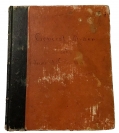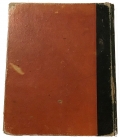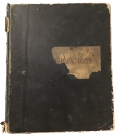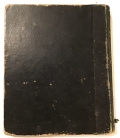site search
online catalog
STONEWALL BRIGADE: GENERAL ORDERS AND REGIMENTAL ORDERS BOOKS OF THE 4th VIRGINIA INFANTRY, APRIL 1861 TO NOVEMBER 1863
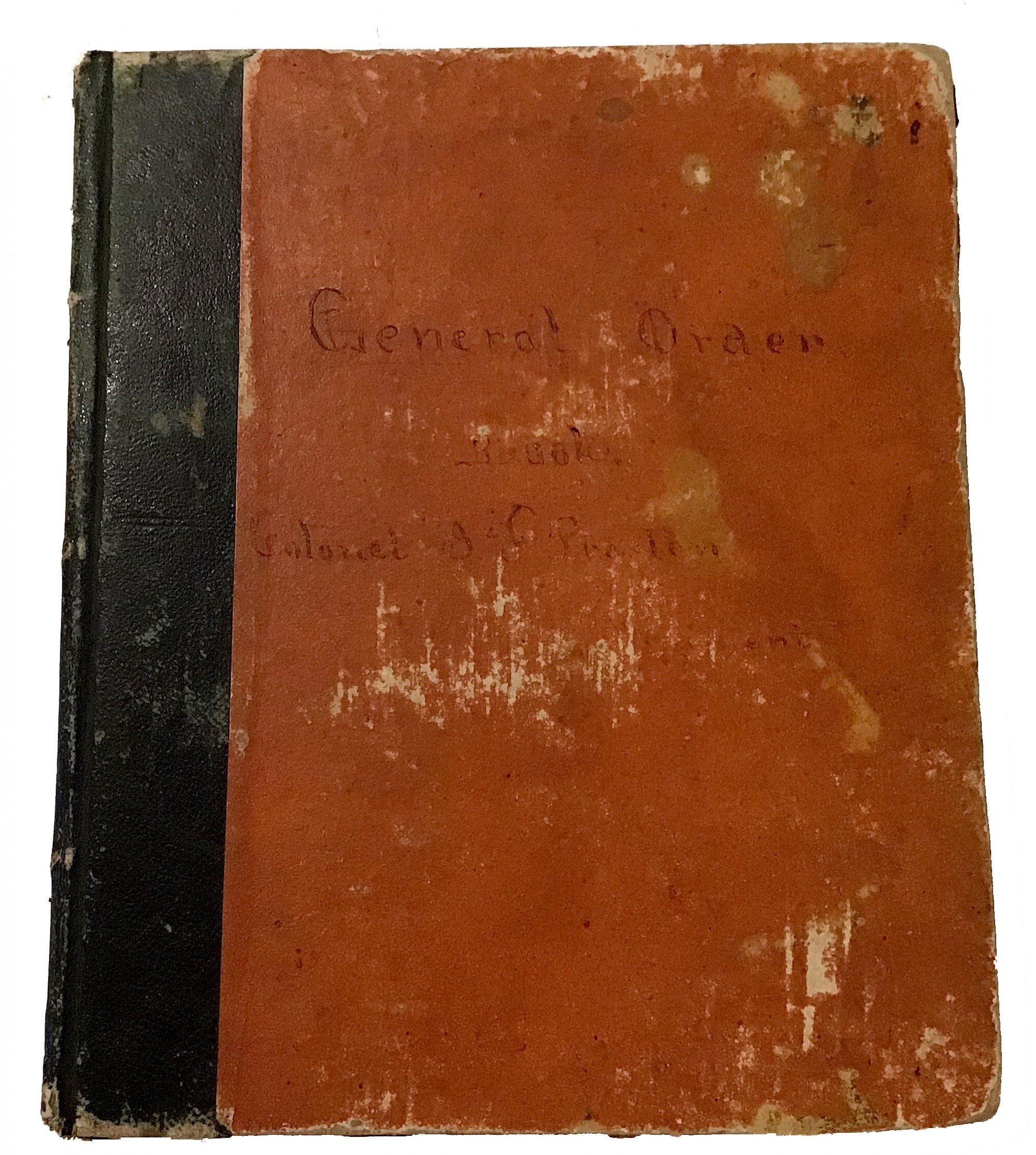
$4,500.00 SOLD
Quantity Available: None
Item Code: 2020-111
The 4th Virginia infantry has a great service record as part of the “Stonewall Brigade.” Organized in April 1861 at Richmond’s Hermitage Fairgrounds under Col. J.F. Preston, it joined Jackson at Harpers Ferry in May, fought under his direct command at Bull Run and then as part of his division and corps, eventually taking part in every major battle of the Army of Northern Virginia. We are proud to offer two of the regiment’s order books that provide a rare view of the inner workings of the regiment and trace its development in training, organization and discipline, include official reports of Bull Run and Fredericksburg, and show the preparations for and the effects of its battles.
Both books are hardbound, about 8.25 by 7 inches, and have 116 lined pages each that are completely filled out in ink. One volume, labeled inside “Book 1,” has orange covers with the handwritten ink title: “General Orders / Book / Col. J.F. Preston.” This covers April 24 through September 7, 1861, and records general and special orders received by the regiment from commanders at the Camp of Instruction in Richmond, from Joe Johnston as army commander, and from Stonewall Jackson as brigade commander. In addition to Jackson, a number of historical personages appear, including notice of General Bee’s appointment to command of the Third Brigade, and notice of his replacement after his death at Bull Run, where he gave Jackson his nickname. There is a wealth of detail showing the business necessary to organize an army of raw volunteers: reminders of regulations, order of rank (including the cadets Jackson had brought from VMI to act as drill instructors,) instructions on how to salute, directives on guard duty, battalion drills, classes for officers on tactics, efforts to uniformly arm companies, reminders that guards should have arms “profusely burnished,” etc.
Many of the early orders show the inexperience of the soldiers, but they become increasingly serious as the regiment joins Jackson at Harpers Ferry, its official designation is established, the Articles of War are read on parade to remind sentinels that the punishment for sleeping on post is death, warnings are published not to write home with details of troop movements, orders are given to remedy deficiencies of ammunition below 40 rounds per man, to prepare badges of recognition for the battlefield, Johnston’s July 6 address to the Army of the Shenandoah that they have “offered battle to the enemy and been declined,” but that he will not attack at a disadvantage, “Our men are Patriots & Freemen” etc. The crisis is reached with a special order from Johnston dated July 18 at Winchester giving notice that Beauregard has been attacked and they are marching to his relief: “Every moment now is precious and the General hopes that his soldiers will step out and keep closed, for this march is a forced march to Save the Country.” The last order before the battle, dated at Manassas on July 19 at 11 O’Clock P.M. issues a watch word for July 20: “Our Home.”
This is followed by orders congratulating the army for its victory, Jackson’s notice July 27, “In accordance with the unanimous resolution of the Congress of the Confederate States, the Genl Commanding the Brigade [desires?] to impress upon it the importance of observing to-morrow as a day of thanksgiving to the God of Battles..,” but also orders reorganizing it after its losses: the assignment of a new commander for the Third Brigade, the sending home of recruiting parties, gathering abandoned Federal supplies, the re-establishment of a camp routine, and also some court-martials. There is a wealth of detail throughout.
Tucked in the back of the book is a copy General Johnston’s Sept. 10, 1861, letter to Jefferson Davis to dispel rumors of inactivity on his part by asserting that he has been treating Beauregard properly as a corps commander and not peppering him with constant orders while the army is stationary, and also reminding Davis that Davis should be exercising the military powers of his position as President. This letter has an official ink stamp on the back it was “examined for war records” and “copied,” so it presumably fell into Federal hands at some point. There is also a D. Appleton backmarked carte-de-visite of Gen. Johnston with the letter. These were likely in the personal possession of the last commanding officer and tucked into the book for safe-keeping.
The second volume has even more information focused on the inner workings of the regiment, recording orders promulgated by the regimental commander: Col. Preston and then mostly by Maj. Terry. There are tons of information on elections of officers, appointments of NCOs, reductions in rank and regimental court-martials, all of which adds to the understanding of the regiment’s experience. The volume is bound in black with the remains of an ink label reading “…]ntal Orders. / ….]antry,” which must have been “Regimental Orders / 4th Virginia Infantry.”
This volume falls into two parts. The first runs from April 29, 1861, at the “Camp of Instruction” at the Hermitage Fairgrounds and goes up to page 37, ending with orders at Camp near Fairfax C.H on Sept. 19, 1861. This includes details of their early organization: reminders of regulations, appointments of officers, designations of companies and line of battle, orders forbidding the carrying of sidearms by privates, vaccinations, established times for lights out, daily battalion drills, recitations of tactics, re-designation of the regiment as the 4th, preparations for a review by Col. Jackson at Harpers Ferry, regulations for a march, and much else.
It also includes Preston’s four-page report of Bull Run, giving details of the regiment’s actions on the field, mentioning a captured Union flag marked “ 8th Regt. N.Y.S.A.” and also details of the losses, the death of Capt. Hale, etc., and ends with the note, “This Mornings report shows a loss of two officers & 28 men killed and 4 officers & 96 men wounded. None are reported as missing. There must be many deaths still amongst the wounded.” And there as a note added: “A Subsequent report shows 110 wounded instead of 100 but many af them very slightly. This is not on the report sent in to the general.” The cost of the battle is then evident in entries for the next month, with numerous orders for elections of new officers, promotions, etc.
The book then jumps to October 1862 on page 38, recording appointments and elections for new officers in the wake of Antietam, along with records of regimental court martials into December, likely the toll of that campaign and battle. The regiment fought again at Fredericksburg and there is a transcript of Major William Terry’s 3 ½ page official report that includes a list of casualties, and then once again there appears a run of reports of court-martials, elections, inspections of supplies, etc., that go through April, 1863, and give sense that the morale of the regiment may have been suffering given the number of court martials for “absence without leave,” which Terry decries to the regiment as a moral depravity next to desertion on March 9. We then get the after-effects of Chancellorsville with promotions to fill vacancies, such as promotion of a corporal to sergeant for “gallant and meritorious conduct at Chancellorsville” to replace a sergeant who had died of wounds, as well as court-martials, boards of survey, etc.
Gettysburg is similarly marked starting on July 10 by the promotion of Corporal Campbell to replace Sergeant Sexton “killed at Battle Gettysburg,” and followed by other consequences of the battle: the transfer of an officer to command a company now missing its officers, the announcement of an election on Sept. 2 “to fill the vacancy occasioned by the death J. Kent Elwing killed in action at Gettysburg, Pa.,” as well as court-martials, promotions and reductions among the NCOs, such as the promotion of Corporal Willis to sergeant for “gallant and soldierly conduct” and the reduction to the ranks of Sergeant Sublett.
The last four pages include a page listing officer casualties at Bull Run, a page listing the dates of commission for the ten captains in the regiment (to determine seniority, likely done at the first organization of the regiment, and then two pages listing officer casualties from October 1862 at “Kearnysville” through November 1863 at “Laurel Hill,” which is better known now as “Payne’s Farm,” part of the Mine Run Campaign.
The amount and depth of detail these order books provide the researcher and historian of the regiment is incredible. Some of the information might be found scattered in individual service records, but much will not. The same holds true for memoirs or regimental histories, where veterans focused on the bigger picture or simply did not remember the day-to-day events of the regiment that built it up or maintained it as a fighting unit. There is also a lot of telling detail in addresses to the regiment to rouse their patriotism or express disappointment in the number of men going AWOL, as well as some humor, such as reminders to officers to write to the appropriate staff officers about specific problems, not to the general commanding, and the court martial and public rebuke of one enlistedman who was so unwise as to bypass all his company and regimental superiors and address a request for a furlough directly to the Secretary of War.
These two order books are wonderful relics of one of the most famous units of the war that would have been carried in field desks of its regimental headquarters and are also a trove of information for the researcher and historian. [sr]
~~~~~~~~~~~~~~~~~~~~~~~~~~~~~~~~~~~
THIS ITEM, AS WITH ALL OTHER ITEMS AVAILABLE ON OUR WEB SITE,
MAY BE PURCHASED THROUGH OUR LAYAWAY PROGRAM.
FOR OUR POLICIES AND TERMS,
CLICK ON ‘CONTACT US’ AT THE TOP OF ANY PAGE ON THE SITE,
THEN ON ‘LAYAWAY POLICY’.
THANK YOU!
Inquire About STONEWALL BRIGADE: GENERAL ORDERS AND REGIMENTAL ORDERS BOOKS OF THE 4th VIRGINIA INFANTRY, APRIL 1861 TO NOVEMBER 1863
For inquiries, please email us at [email protected]
Most Popular
Historical Firearms Stolen From The National Civil War Museum In Harrisburg, Pa »
Theft From Gravesite Of Gen. John Reynolds »
Cavalry Carbine Sling Swivel »
Fine Condition Brass Infantry Bugle Insignia »
featured item
CDV OF LOUIS R. FRANCINE, 7TH NEW JERSEY INFANTRY, MORTALLY WOUNDED AT GETTYSBURG
Image shows Francine in uniform. He wears a non-regulation coat with shoulder straps (Major or Lt. Colonel). Image is clear with good contrast. Mount has two small chips to border along top edge. Reverse has pencil identification. Photographer’s… (2021-1131). Learn More »



